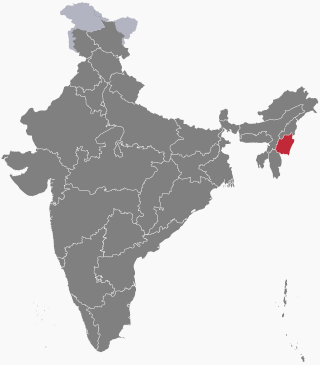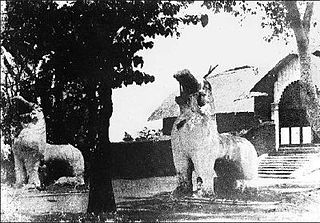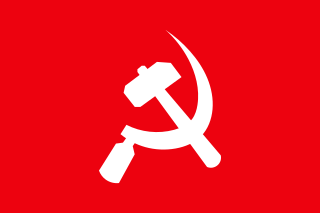Related Research Articles

Manipur is a state in northeast India, with the city of Imphal as its capital. It is bounded by the Indian states of Nagaland to the north, Mizoram to the south and Assam to the west. It also borders two regions of Myanmar, Sagaing Region to the east and Chin State to the south. The state covers an area of 22,327 km2 (8,621 sq mi). The official and most widely spoken language is the Meitei language. Native to the Meitei people, it is also used as a lingua franca by smaller communities, who speak a variety of other Tibeto-Burman languages. Manipur has been at the crossroads of Asian economic and cultural exchange for more than 2,500 years. This exchange connects the Indian subcontinent and Central Asia to Southeast Asia, East Asia, Siberia, regions in the Arctic, Micronesia and Polynesia enabling migration of people, cultures and religions.

The Meitei people, also known as Meetei, Manipuri people, is an ethnic group native to Manipur. They form the largest and dominant ethnic group of Manipur in Northeast India. They speak the Meitei language, one of the 22 official languages of the Republic of India and the sole official language of Government of Manipur. The Meiteis primarily settled in the Imphal Valley region in modern-day Manipur, though a sizeable population has settled in the other Indian states of Assam, Tripura, Nagaland, Meghalaya, and Mizoram. There is also a notable presence of Meitei people in the neighbouring countries of Myanmar and Bangladesh. The Meitei ethnic group represents about 53% of Manipur's population.
Nikhil Manipuri Mahasabha, initially called Nikhil Hindu Manipuri Mahasabha, was founded in Manipur in 1934 with the Maharaja Churachand Singh as its president. The organisation was focused mainly on the ethnic interests of the Meitei people and their religious interests as Hindus.
The All India States Peoples Conference (AISPC) was a conglomeration of political movements in the princely states of the British Raj, which were variously called Praja Mandals or Lok Parishads. The first session of the organisation was held in Bombay in December 1927. The Conference looked to the Indian National Congress for support, but Congress was reluctant to provide it until 1939, when Jawaharlal Nehru became its president, serving in this position till 1946. After the Indian Independence, however, the Congress distanced itself from the movement, allying itself with the princely rulers via its national government's accession relationships.
The history of Manipur is reflected by archaeological research, mythology and written history. Historically, Manipur was an independent sovereign kingdom ruled by Meitei dynasty but at different point of time it was invaded and rule over by other state and authority. The Kangleipak State developed under King Loiyumba with its first written constitution in the early 12th century. Manipur under the 18th-century king Pamheiba saw the legendary burning of sacred scripture.

Hijam Irabot, also known as Jana Neta Hijam Irabot, was a politician and leader of Communist party of India and revolutionary social activist from Manipur. He fought against the social evils of the society. He later was jailed for supporting the second Nupi Lan, 1939. In the June/July 1948 election to the Manipur Assembly, Irabot won from the Utlou Constituency.
The Kabaw Valley also known as Kubo valley is a highland valley in Myanmar's western Sagaing Division, close to the border with India's Manipur. The valley is located between Yomadong range of mountains, which constitute the present-day India–Myanmar border, and the Chindwin River.
Khampat (ခမ်းပါတ်မြို့) is a town in the Kabaw Valley in the Sagaing Region in western Myanmar. It is at the location where the Namsaweng River flows down from the hills and enters the Kabaw Valley. It is the site of a historical principality, which often changed hands between Manipur and the Burmese kingdoms to the east.

Meitei literature, also known as Manipuri literature, is literature written in the Meitei language of Manipur. An ancient institution of learning, the Luwang Nonghumsang, later known as the Pandit Loishang, collected sources of indigenous Meitei knowledge and philosophy until the 18th century. Writing by Meiteis is assumed to go back to the Kingdom of Kangleipak in the early 12th century. The Meitei script is a Brahmic abugida. It is known only from the Puya manuscripts discovered in the first half of the 20th century. Manuscripts of the 18th and 19th centuries were written using the Bengali alphabet. The existence of the Meitei script in the 15th-century hinges on the authenticity of an inscription dated to the reign of Senbi Kiyamba. The first printed Manipuri book, Manipurer Itihas, appeared in 1890 from the Baptist Mission Press, Calcutta. Though the kings of Manipur had established contact with the British from the middle of the eighteenth century onward the real impact of the contact came much later. Johnstone Middle English School, based on the western system of education, was started in 1885 at Imphal, and in 1891 Manipur lost its independence to the British. British domination facilitated the introduction of new systems in the civil, political and educational spheres, which hastened the process of modernization in Manipur, exposed as it was to new ideas and influences.

The Ningthouja dynasty, also known as Mangang dynasty, comprises the descendants of the kings of Manipur. Ningthouja literally means progeny of King. It has 125 extended families. It was apparently founded by King Nongdā Lāiren Pākhangba in 33 CE.

The Manipur Kingdom also known as Meckley was an ancient kingdom at the India–Burma frontier. Historically, Manipur was an independent kingdom ruled by a Meitei dynasty. But it was also invaded and ruled over by Burmese kingdom at various point of time. It became a protectorate of the British East India Company from 1824, and a princely state of British Raj in 1891. It bordered Assam Province in the west and British Burma in the east, and in the 20th century covered an area of 22,327 square kilometres and contained 467 villages. The capital of the state was Imphal.

Maharaja Bodhchandra Singh or Bodhachandra Singh (1908–1955) was the last ruler of the princely state of Manipur under the British Raj as well as the Dominion of India. He ruled between 1941 and 15 October 1949. During his term, India was decolonised by the British, receiving independence on 14 August 1947. The Maharaja presided over a transition to democracy, passing the Manipur State Constitution Act 1947. He signed the Instrument of Accession, joining India shortly before the British departure. In 1949, a few months before India became a republic, he signed a merger agreement, whereby Manipur became an integral part of India governed by the Constitution of India.
The Nupi Lan were two demonstrations led by women in Manipur, British India against the colonial authorities. In 1904, the first Nupi Lan broke out in response to an order by the colonial authorities to send Manipuri men to the Kabow Valley to fetch timber for re-building the then Police Agent's bungalow. The second Nupi Lan broke out in 1939 in response to the export of rice during the Second World War.

The Insurgency in Manipur is an ongoing armed conflict between India and a number of separatist rebel groups, taking place in the state of Manipur. The Insurgency in Manipur is part of the wider Insurgency in Northeast India; it displays elements of a national liberation war as well as an ethnic conflict.

The Anglo-Manipur War or Manipuri Rebellion of 1891 was a short armed conflict between the British Colonial Forces and the dissenting royal princes of Manipur Kingdom, which was arguably a dependency of the British Empire in India. The conflict began with a palace coup staged by the general (Senapati) of Manipur, ousting its reigning king, and installing a half-brother, the heir-apparent, in his place. The British government took objection to the action and attempted to arrest the general. The effort failed, with the Manipuri forces attacking the British residency and the resident and other British officials getting executed. The British launched a punitive expedition that lasted from 31 March to 27 April 1891. The general and other rebels were arrested and convicted. The British conquered Manipur and did not annex it under British India but governed it as a princely state till 1947.
The following is a timeline of the Kashmir conflict during the period 1846–1946.
Manipur State Constitution Act 1947 is an act which enabled the princely state of Manipur to have a de jure written constitution enacted by the last Maharajah of Manipur, Bodhchandra Singh. Under the constitution, a Legislative Assembly was elected in mid-1948 and a ministry was formed, which was responsible to the Maharaja. The constitution is deemed to have lapsed on 15 October 1949, when the Maharaja signed a merger agreement with the Indian Union. The validity of the act in present time is debated.

Meitei nationalism refers to nationalism among the Meitei people. In the Meitei context this includes various movements throughout history to sustain Meitei cultural identity, political boundary, ethnicity and history to regain sovereign state status of Kangleipak.

Communist movements in India refers to the various social and political movements led by communists in India. Communism in India has existed since the 1920s. Some of the major events are listed below.
References
- ↑ Parratt & Parratt, Hijam Irabot (2000) [ page needed ]
- ↑ Parratt & Parratt, Hijam Irabot (2000) [ page needed ]
- 1 2 Thoiba Singh, Wakambam (1984). Meetei Polity – A study of the socio-economic and political changes among the Meeteis from 1750 to 1950 (Thesis). Guwahati University/Shodhganga. p. 228-232 (Chapter 5). hdl: 10603/69732 .
- ↑ Indrakumar, Colonialism and Movement for Democracy (2015) [ page needed ]
- ↑ Indrakumar, Colonialism and Movement for Democracy (2015) [ page needed ]
- ↑ Parratt & Parratt, Hijam Irabot (2000) [ page needed ]
- ↑ Parratt, Wounded Land (2005), pp. 94–95: "Some in the NMM, whether through genuine concern at possible Communist infiltration or simply through envy, were clearly unhappy with Irabot's participation in the deliberations, and swiftly plotted to remove him from the political scene.".
- 1 2 Parratt, Wounded Land (2005), pp. 94–95.
- ↑ Parratt, Wounded Land (2005), pp. 95–96: "Bodhchandra had by this time accepted proposals for an assembly, and on 21 September 1946 he wrote to the Political Agent asking for the Government's approval to make a declaration which would lead to responsible government.".
- 1 2 3 Parratt, Wounded Land (2005), pp. 95–96.
- ↑ Meetei, Narrating the Nation in Manipur (2018), pp. 116-117: "The Manipur state Congress Unit formed in 1946 as an extension of the Indian National Congress (INC), which had advocated integration... ".
- ↑ Constantine, R. (1981), Manipur, Maid of the Mountains, Lancers, p. 86,
... the Nikhil Manipur Mahasabha which had by then become the Manipur State Congress, was part and parcel of the Indian National Congress which brought about Independence.
- ↑ Tarapot, Bleeding Manipur (2003), pp. 170–171: "This party was not a unit of the Indian National Congress and had no link with the INC.".
- ↑ Parratt, Wounded Land (2005), p. 101: "The Manipur State Congress did not originate in the Indian National Congress (as some have argued), and only gradually came under its umbrella, partly at least because its leaders saw this connection as a means of consolidating their power in the state.".
- ↑ Ramusack, Congress and the People's Movement in Princely India (1988), p. 377: "Congress was oriented primarily towards institutions and events in the British-controlled provinces of India and in some ways was as ambiguous and negligent in its policies toward political activity in the princely states as the British were toward their rulers.".
- ↑ McLeod, Sovereignty, Power, Control (1999), pp. 44–45.
- ↑ Chishti, Political Development in Manipur (2005), pp. 90–92: "It was quite apparent that the leaders of the Nikhil Manipuri Mahasabha also received regular instructions from the Sylhet and Gauhati Congresses. Irabot occasionally visited Gauhati and Sylhet to see the President of the Assam Provincial Committee with a view to receive instructions.".
- ↑ Ramusack, Congress and the People's Movement in Princely India (1988), p. 393.
- ↑ Sudhirkumar Singh, Socio-religious and Political Movements (2011).
- ↑ Indrakumar, Colonialism and Movement for Democracy (2015), pp. 67–68.
- ↑ Sudhirkumar Singh, Socio-religious and Political Movements (2011), pp. 117–118.
- ↑ Indrakumar, Colonialism and Movement for Democracy (2015), p. 67.
- ↑ Indrakumar, Colonialism and Movement for Democracy (2015), pp. 68–69.
- ↑ Dena, Lal (1991), History of Modern Manipur, 1826-1949, Orbit Publishers-Distributors
- ↑ Sudhirkumar Singh, Socio-religious and Political Movements (2011), p. 139.
- ↑ Sudhirkumar Singh, Socio-religious and Political Movements (2011), pp. 139–140.
- ↑ Parratt, Wounded Land (2005), pp. 97–99.
- ↑ Sudhirkumar Singh, Socio-religious and Political Movements (2011), pp. 123–124.
- ↑ Chishti, Political Development in Manipur (2005), pp. 120–121.
- ↑ Indrakumar, Colonialism and Movement for Democracy (2015), p. 69.